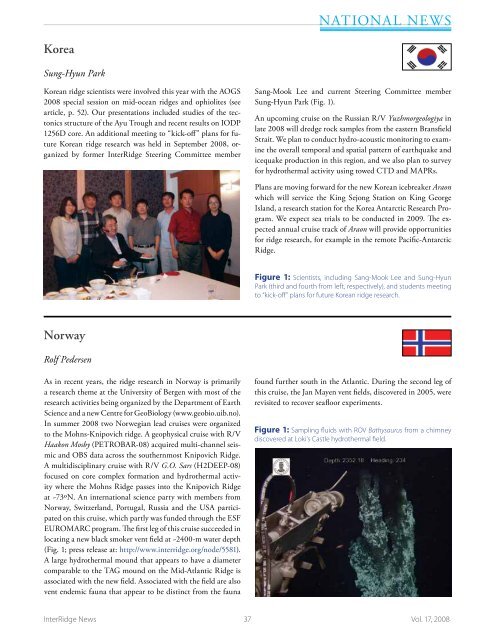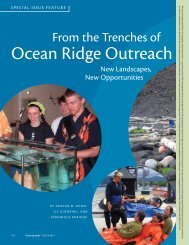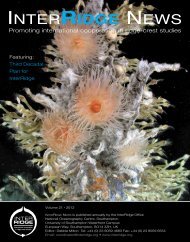Full version, lower resolution, 3.25MB - InterRidge
Full version, lower resolution, 3.25MB - InterRidge
Full version, lower resolution, 3.25MB - InterRidge
Create successful ePaper yourself
Turn your PDF publications into a flip-book with our unique Google optimized e-Paper software.
National News<br />
Korea<br />
Sung-Hyun Park<br />
Korean ridge scientists were involved this year with the AOGS<br />
2008 special session on mid-ocean ridges and ophiolites (see<br />
article, p. 52). Our presentations included studies of the tectonics<br />
structure of the Ayu Trough and recent results on IODP<br />
1256D core. An additional meeting to “kick-off” plans for future<br />
Korean ridge research was held in September 2008, organized<br />
by former <strong>InterRidge</strong> Steering Committee member<br />
Sang-Mook Lee and current Steering Committee member<br />
Sung-Hyun Park (Fig. 1).<br />
An upcoming cruise on the Russian R/V Yuzhmorgeologiya in<br />
late 2008 will dredge rock samples from the eastern Bransfield<br />
Strait. We plan to conduct hydro-acoustic monitoring to examine<br />
the overall temporal and spatial pattern of earthquake and<br />
icequake production in this region, and we also plan to survey<br />
for hydrothermal activity using towed CTD and MAPRs.<br />
Plans are moving forward for the new Korean icebreaker Araon<br />
which will service the King Sejong Station on King George<br />
Island, a research station for the Korea Antarctic Research Program.<br />
We expect sea trials to be conducted in 2009. The expected<br />
annual cruise track of Araon will provide opportunities<br />
for ridge research, for example in the remote Pacific-Antarctic<br />
Ridge.<br />
Figure 1: Scientists, including Sang-Mook Lee and Sung-Hyun<br />
Park (third and fourth from left, respectively), and students meeting<br />
to “kick-off” plans for future Korean ridge research.<br />
Norway<br />
Rolf Pedersen<br />
As in recent years, the ridge research in Norway is primarily<br />
a research theme at the University of Bergen with most of the<br />
research activities being organized by the Department of Earth<br />
Science and a new Centre for GeoBiology (www.geobio.uib.no).<br />
In summer 2008 two Norwegian lead cruises were organized<br />
to the Mohns-Knipovich ridge. A geophysical cruise with R/V<br />
Haakon Mosby (PETROBAR-08) acquired multi-channel seismic<br />
and OBS data across the southernmost Knipovich Ridge.<br />
A multidisciplinary cruise with R/V G.O. Sars (H2DEEP-08)<br />
focused on core complex formation and hydrothermal activity<br />
where the Mohns Ridge passes into the Knipovich Ridge<br />
at ~73ºN. An international science party with members from<br />
Norway, Switzerland, Portugal, Russia and the USA participated<br />
on this cruise, which partly was funded through the ESF<br />
EUROMARC program. The first leg of this cruise succeeded in<br />
locating a new black smoker vent field at ~2400-m water depth<br />
(Fig. 1; press release at: http://www.interridge.org/node/5581).<br />
A large hydrothermal mound that appears to have a diameter<br />
comparable to the TAG mound on the Mid-Atlantic Ridge is<br />
associated with the new field. Associated with the field are also<br />
vent endemic fauna that appear to be distinct from the fauna<br />
found further south in the Atlantic. During the second leg of<br />
this cruise, the Jan Mayen vent fields, discovered in 2005, were<br />
revisited to recover seafloor experiments.<br />
Figure 1: Sampling fluids with ROV Bathysaurus from a chimney<br />
discovered at Loki’s Castle hydrothermal field.<br />
<strong>InterRidge</strong> News 37 Vol. 17, 2008
















